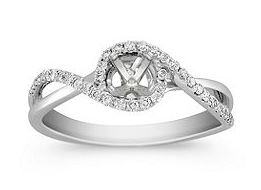
If you’re looking for the perfect engagement ring, you’ll likely spend time window-shopping, online shopping, and looking around for the ring that speaks to your heart. It’s important to remember that when shopping for such a large investment, you should learn a little bit about how to spot a high quality diamond. Taking the time to learn a brief overview of the “four C’s” will go a long way when diamond shopping, and help make sure you find something that speaks to your heart.
Carat
The first “C” is one that most people have heard of – the “carat” or weight of the diamond.
Precious gems are sold by the carat, or ct, which refers not to how large the diamond is size wise, but to how much the diamond weighs. The term started in the early trading days of gemstones, when carob seeds were used to measure the weight of a diamond. The word carat is derived from the Arabic word for carob, hence the name. Today, each diamond is weighed with very accurate, sensitive scales to make sure the weight is exact.
Clarity
A diamond’s purity is defined as its clarity, which is determined by the presence or absence of natural identifying marks on the gem. All diamonds are identifiable by natural “birthmarks” present within the stone that make it unique from any other diamond. Only the rarest of gemstones are given the rating of “FL”, which stands for flawless, meaning that no inclusions or blemishes can be seen when examined under 10X magnification. The vast majority have some kind of mineral inclusions, which result from trapped materials that cause speck, dark spots, or open cavities on the original diamond surface, or cracks called feathers caused by stress during the formation of the diamond. You may be able to save money on a larger diamond if you like something that is lower on the clarity grading scale.
Color
The quality of the diamond is determined, thirdly, by the quality of its color. This refers primarily to the absence of color, since colorless gemstones are the most rare. The rarer a type of diamond, the more it will cost. Since most mined stones have body color, a grading scale has been developed to distinguish them from each other. Grades range from “D” or completely colorless, like pure water, down to “Z” which is light yellow in color. The exception to the colorless rule is a fancy colored diamond, which is quite rare and considered a collectors item.
These diamonds may be a shade of pink, yellow, green, brown or blue. Though differences in color are very difficult to see because they are so subtle, a small difference in color can make a huge difference in price.
Cut
Lastly, but perhaps one of the most important “C’s” is the cut, or make of the diamond. The way a precious gem is cut has a huge impact on its sparkle, or brilliance. If a stone is cut too shallow, or too deep, the light will leak out of the sides and bottom rather than reflecting back to the viewer. Even a diamond with exceptional quality in the other 3 C’s can be devalued greatly by a poor cut, since it’s the finishing touch on a diamond.
Pay attention to carat, clarity, color and cut when you are shopping, and most importantly, trust your eyes to see the beauty of the right diamond for your special engagement ring.



